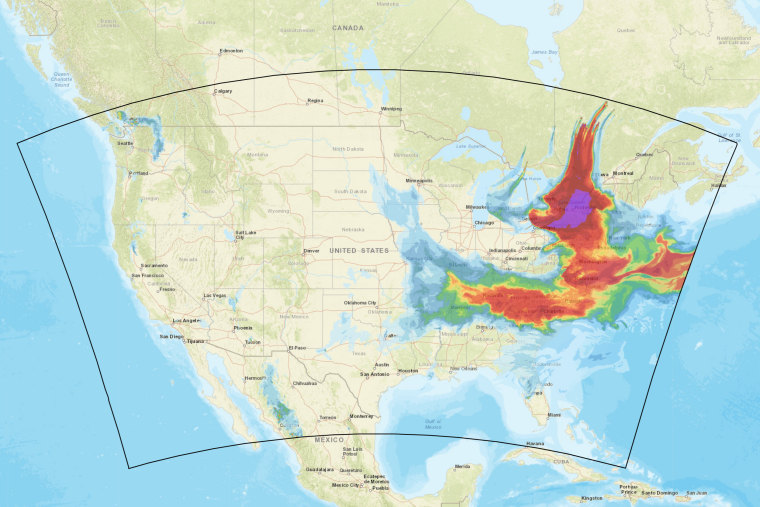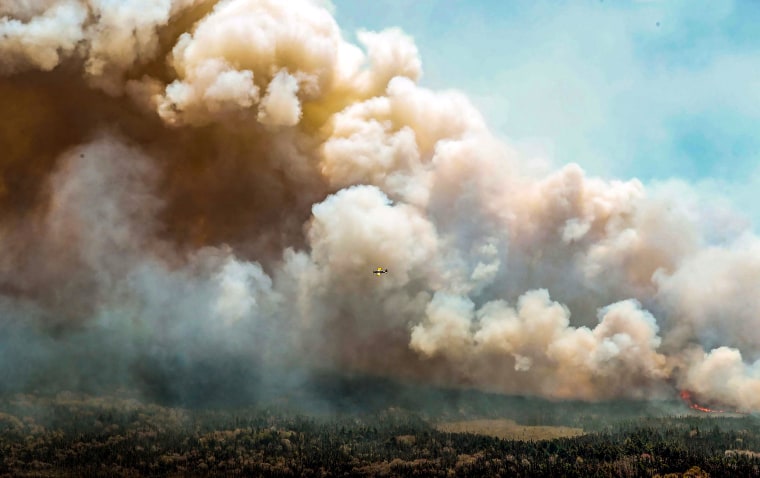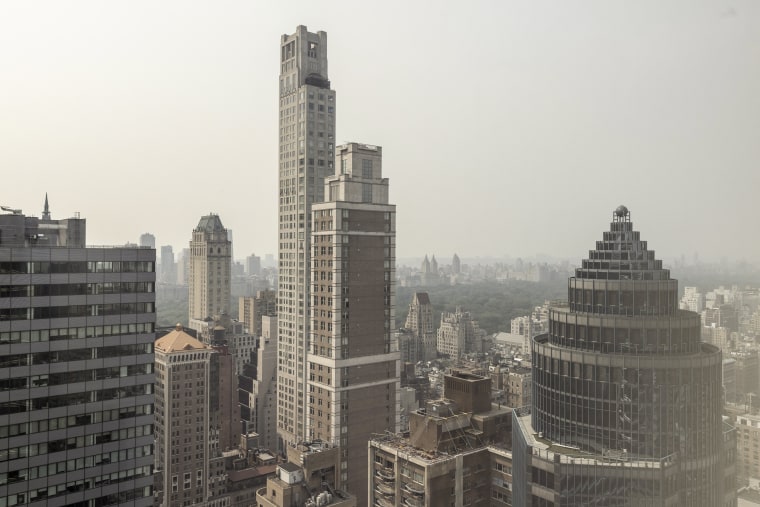Editor's note: This story was initially published Monday, June 5, and has been extensively updated. For today's coverage, please click here.
Air quality remained unhealthy for tens of millions of people across the U.S. on Thursday, as smoke from wildfires in Canada continued to spread throughout the Midwest and the Eastern Seaboard.
About 123 milion people were under air quality alerts on Thursday morning. More than 400 wildfires are burning in Canada, according to the Canadian Interagency Forest Fires Centre.
Follow live coverage of U.S. air quality conditions and Canada’s wildfires
An air quality advisory remains in effect for several regions of New York, with monitoring stations in most parts of the state measuring pollution levels considered unhealthy for sensitive groups, and stations in the Eastern Lake Ontario, Central and New York City metro areas measuring air quality levels considered unhealthy for anyone, as of Wednesday morning.
Health officials advised limiting strenuous outdoor activity "to reduce the risk of adverse health effects," and Gov. Kathy Hochul recommended that New York school districts cancel outdoor activities.

It was the third day of hazy skies across a wide stretch of the country. Smoke blanketed the landscape from the Ohio Valley to as far south as the Carolinas on Monday. Air quality advisories were in effect Monday in southeastern Minnesota and parts of the Upper Peninsula of Michigan, as well as in more than 60 counties in Wisconsin.
Follow live coverage on U.S. air quality conditions and Canada wildfires
More smoke was expected Wednesday in New York City, which ranked fourth among major cities worldwide for the worst air quality around 12:30 p.m. ET Wednesday, according to IQAir, a Swiss air monitoring company.
"The expectation is the low level smoke will increase in concentration heading into the afternoon as another significant push comes down from the north and west," the National Weather Service said in a forecast Wednesday.
Late Tuesday, New York City Public Schools said all of its schools would cancel outdoor activities because of the air quality alert.

Air pollution is spiking from wildfires that have been raging in the Canadian provinces of Quebec and Nova Scotia as Canada experiences one of the worst starts to its wildfire season ever recorded.
Some 414 fires were burning in Canada on Tuesday evening including 239 considered "out of control," the Canadian Interagency Forest Fire Centre said. More than 6.7 million acres have already burned this year, federal officials said last week.
Fire weather was developing in the U.S., too. The National Weather Service's storm prediction center said Tuesday that "dry thunderstorms" — common firestarters — could spark blazes in the mid-Atlantic. Gusty conditions could spread the fires and make them difficult to control.
In recent days, smoke from the fires has been drifting over the northeastern U.S. and settling across the Midwest. Alerts warning of elevated concentrations of air pollution were issued across the regions, particularly for “sensitive groups,” including children, older adults and people with asthma and other respiratory conditions.
A growing health risk
Air pollution from wildfire smoke has become a significant health risk in the U.S., and it is growing worse. Stanford University researchers found that the number of people who experienced at least one day with unhealthy air quality because of smoke rose by 27 times over the last decade.
Small particles in smoke that are less than 2.5 micrometers in diameter — about 4% of the diameter of an average human hair — are of particular concern to air quality researchers.
“These are the particles that are small enough to breathe in and can cause cardiovascular issues,” said Brett Palm, a scientist at the National Center for Atmospheric Research in Boulder, Colorado.
Exposure to such pollution can cause inflammation and weaken the immune system, particularly when the tiny particles penetrate the lungs and enter the bloodstream. Particulate pollution may increase the risk of asthma, lung cancer or other chronic lung diseases, particularly in vulnerable groups like older people, pregnant people, infants and children.
Wildfire smoke exposure might also increase the risk of respiratory disease. Increases of Covid-19 and influenza have also been linked to wildfire smoke.

The good news: Portable air purifiers can be highly effective, reducing indoor particle concentrations by as much as 85 percent, according to the Environmental Protection Agency.
Experts say to choose air purifiers that have high efficiency particulate air (HEPA) filters and a clean air delivery rate — a metric of how effective they are at removing pollutants — of at least two-thirds the size of the room they are intended for.
“You really want to get the biggest one that you can afford, and that fits in your room,” said Dr. Barbara Mann, a pulmonologist and assistant professor of medicine at the Icahn School of Medicine at Mount Sinai in New York.
For most rooms, a clean air delivery rate equal to 300 or more cubic feet per minute should be enough, she said.
To maximize air purifiers’ effectiveness, change their filters at the recommended intervals and keep windows closed when using them, Mann added.
Also be mindful of pollutants that can come from indoor sources, said Dr. Peter Moschovis, a pulmonologist and critical care physician at Massachusetts General Hospital and an assistant professor at Harvard Medical School.
“Don’t generate extra particles indoors if you can,” he said. “So, smoking, vaping, burning incense, aerosolized essential oils — all those things aren’t good for your lungs at baseline.”
Palm said the current situation highlights the longer-term risks of wildfires, particularly as climate change creates warmer and drier conditions that make such blazes more likely — and more severe.
“Over the last decade or so, these fires have been increasing and are having increasing impacts not just where the fires are, but far downwind from there,” he said.
The U.S. Environmental Protection Agency — along with partner agencies such as the National Oceanic and Atmospheric Administration and NASA — maintains an interactive map of air quality data called AirNow that allows users to see the locations of active fires and assess local conditions and risks.

